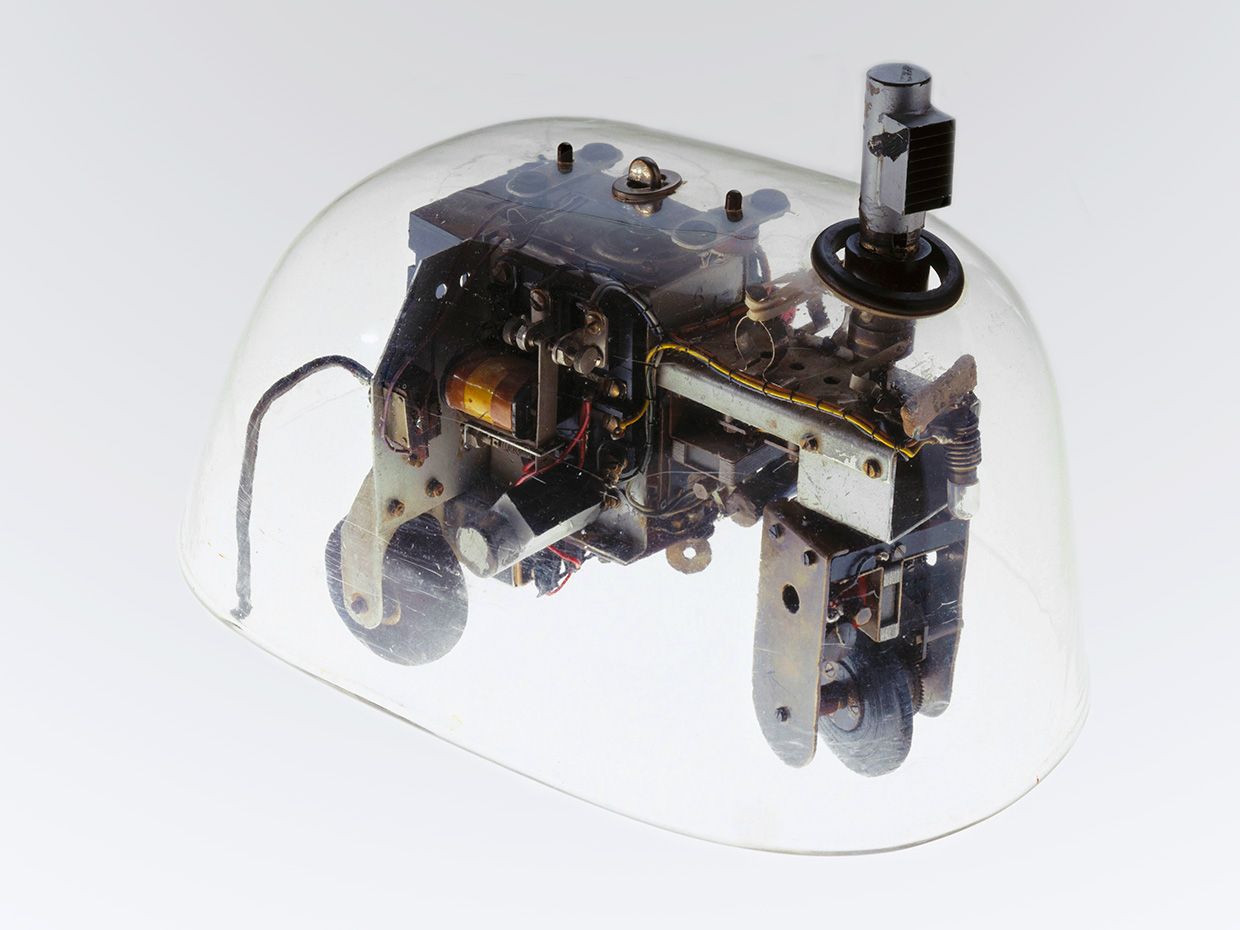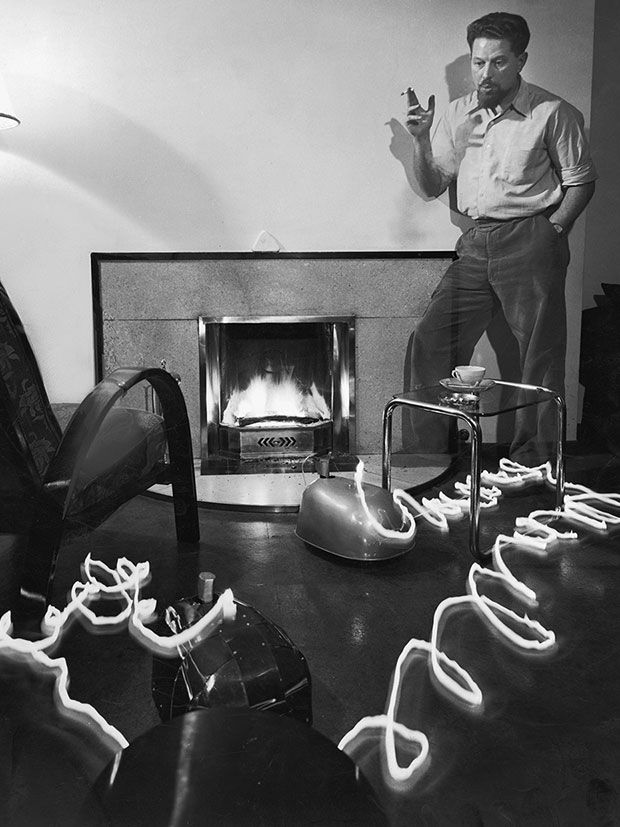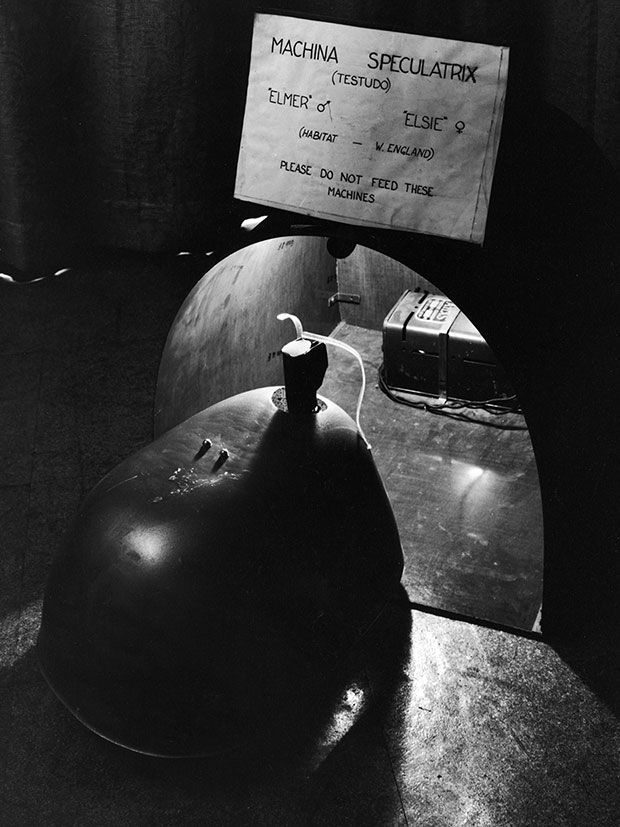Meet the Roomba’s Ancestor: The Cybernetic Tortoise
 Photo: Science and Society Picture Library/Getty Images Neurophysiologist W. Grey Walter built his cybernetic tortoises to elucidate the functions of the brain.
Photo: Science and Society Picture Library/Getty Images Neurophysiologist W. Grey Walter built his cybernetic tortoises to elucidate the functions of the brain. In the robotics family tree, Roomba's ancestors were probably Elmer and Elsie, a pair of cybernetic tortoises invented in the 1940s by neurophysiologist W. Grey Walter. The robots could "see" by means of a rotating photocell that steered them toward a light source. If the light was too bright, they would retreat and continue their exploration in a new direction. Likewise, when they ran into obstacles, a touch sensor would compel the tortoises to reverse and change course. In this way, Elmer and Elsie slowly explored their surroundings.
Walter was an early researcher into electroencephalography (EEG), a technique for detecting the electrical activity of the brain using electrodes attached to the scalp. Among his notable clinical breakthroughs was the first diagnosis of a brain tumor by EEG. In 1939 he joined the newly established Burden Neurological Institute in Bristol, England, as head of its physiology department, and he remained at the Burden for the rest of his career.
Norbert Wiener's cybernetics movement gave birth to a menagerie of cybernetic creaturesIn the late 1940s, Walter became involved in the emerging community of scientists who were interested in cybernetics. The field's founder, Norbert Wiener, defined cybernetics as "the scientific study of control and communication in the animal and the machine." In the first wave of cybernetics, people were keen on building machines to model animal behavior. Claude Shannon played around with a robotic mouse named Theseus that could navigate mazes. W. Ross Ashby built the Homeostat, a machine that automatically adapted to inputs so as to remain in a stable state.
Walter's contribution to this cybernetic menagerie was an electromechanical tortoise, which he began working on in the spring of 1948 in his spare time. His first attempts were inelegant. In 1951 W. J. "Bunny" Warren, an electrical engineer at the Burden, constructed six tortoises for Walter that were more solidly engineered. Two of these six tortoises became Elmer and Elsie, their names taken from Grey's somewhat contrived acronym: ELectro MEchanical Robots, Light Sensitive, with Internal and External stability.
 Photo: Larry Burrows/The LIFE Picture Collection/Getty Images In this time-lapse photo from 1950, Walter has a smoke while one of his cybernetic tortoises roams about the living room.
Photo: Larry Burrows/The LIFE Picture Collection/Getty Images In this time-lapse photo from 1950, Walter has a smoke while one of his cybernetic tortoises roams about the living room. Walter considered Elmer and Elsie to be the Adam and Eve of a new species, Machina speculatrix. The scientific nomenclature reflected the robots' exploratory or speculative behavior. The creatures each had a smooth protective shell and a protruding neck, so Walter put them in the Linnaean genus Testudo, or tortoise. Extending his naming scheme, he dubbed Shannon's maze-crawling mouse Machina labyrinthia and Ashby's Homestat Machina sopora (sleeping machine).
Did W. Grey Walter's cybernetic tortoises exhibit free will?Each tortoise moved on three wheels with two sets of motors, one for locomotion and the other for steering. Its "brain" consisted of two vacuum tubes, which Walter said gave it the equivalent of two functioning neurons.
Despite such limited equipment, the tortoises displayed free will, he claimed. In the May 1950 issue of Scientific American [PDF], he described how the photocell atop the tortoise's neck scanned the surroundings for a light source. The photocell was attached to the steering mechanism, and as the tortoise searched, it moved forward in a circular pattern. Walter compared this to the alpha rhythm of the electric pulses in the brain, which sweeps over the visual areas and at the same time releases impulses for the muscles to move.
In a dark room, the tortoise wandered aimlessly. When it detected a light, the tortoise moved directly toward the source. But if the light surpassed a certain brightness, it retreated. Presented with two distinct light sources, it would trace a path back and forth between the pair. "Like a moth to a flame," Walter wrote, the tortoise oscillated between seeking and withdrawing from the lights.
The tortoise had a running light that came on when it was searching for a light source. Originally, this was just to signal to observers what command the robot was processing, but it had some unintended consequences. If Elmer happened to catch a glimpse of itself in a mirror, it would begin moving closer to the image until the reflected light became too bright, and then it would retreat. In his 1953 book The Living Brain, Walter compared the robot to "a clumsy Narcissus."
Similarly, if Elmer and Elsie were in the same area and saw the other's light, they would lock onto the source and approach, only to veer away when they got too close. Ever willing to describe the machines in biological terms, Walter called this a mating dance where the unfortunate lovers could never "consummate their 'desire.' "
The tortoise's shell did much more than just protect the machine's electromechanical insides. If the robot bumped into an obstacle, a touch sensor in the shell caused it to reverse and change direction. In this manner it could explore its surroundings despite being effectively blind.
M. speculatrix was powered by a hearing-aid battery and a 6-volt battery. When its wanderings were done-that is, when its battery levels were low-it made its way to its hutch. There, it could connect its circuits, turn off its motors, and recharge.
Elmer and Elsie were a huge hit at the 1951 Festival of BritainDuring the summer of 1951, Elmer and Elsie performed daily in the science exhibition at the Festival of Britain. Held at sites throughout the United Kingdom, the festival drew millions of visitors. The tortoises were a huge hit. Attendees wondered at their curious activity as they navigated their pen, moved toward and away from light sources, and avoided obstacles in their path. A third tortoise with a transparent shell was on display to showcase the inner workings and to advertise the component parts.
Even as M. speculatrix was wowing the public, Walter was investigating the next evolution of the species. Elmer and Elsie successfully demonstrated unpredictable behavior that could be compared with a basic animal reaction to stimuli, but they never learned from their experience. They had no memory and could not adapt to their environment.
Walter dubbed his next experimental tortoise M. docilis, from the Latin for teachable, and he attempted to build a robot that could mimic Pavlovian conditioned responses. Where the Russian psychologist used dogs, food, and some sort of sound, Walter used his cybernetic tortoises, light, and a whistle. That is, he taught his M. docilis tortoises that the sound of a whistle was the same as a light source and that the tortoise would move toward the sound even if no light was present.
Walter published his findings on M. docilis in a second Scientific American article, "A Machine That Learns" [PDF]. This follow-up article had much to offer electrical engineers, including circuit diagrams and a technical discussion of some of the challenges in constructing the robots, such as amplifying the sound of the whistle to overcome the noise of the motors.
 Photo: Larry Burrows/The LIFE Picture Collection/Getty Images The robo-tortoise returns to its hutch to recharge its battery.
Photo: Larry Burrows/The LIFE Picture Collection/Getty Images The robo-tortoise returns to its hutch to recharge its battery. The brain of M. docilis was CORA (short for COnditioned Reflex Analog) circuitry, which detected repeated coincidental sensory inputs on separate channels, such as light and sound that happened at the same time. After CORA logged a certain number of repetitions, often between 10 and 20 instances, it linked the resulting behavior, which Walter described as a conditioned response. Just as CORA could learn a behavior, it could also forget it. If the operator teased the tortoise by withholding the light from the sound of the whistle, CORA would delink the response.
At the end of his article, Walter acknowledged that future experiments with more circuits and inputs were feasible, but the increase in complexity would come at the cost of stability. Eventually, scientists would find it too difficult to model the behavior and understand the reactions to multiple stimuli.
Walter discontinued his experiments with robotic tortoises after CORA, and the research was not picked up by others. As the historian of science Andrew Pickering noted in his 2009 book, The Cybernetic Brain, "CORA remains an unexploited resource in the history of cybernetics."
Walter's legacy lives on in his tortoises. The late Rueben Hoggett compiled a treasure trove of archival research on Walter's tortoises, which can be found on Hoggett's website, Cybernetic Zoo. The three tortoises from the Festival of Britain were auctioned off, and the winner, Wes Clutterbuck, nicknamed them Slo, Mo, and Shun. Although two were later destroyed in a fire, the Clutterbuck family donated the one with a transparent shell to the Smithsonian Institution. The only other known surviving tortoise from the original six crafted by Bunny Warren is at the Science Museum in London. It is currently on exhibit in the Making the Modern World Gallery.
An abridged version of this article appears in the March 2020 print issue as "The Proto-Roomba."
Part of a continuing series looking at photographs of historical artifacts that embrace the boundless potential of technology.
About the AuthorAllison Marsh is an associate professor of history at the University of South Carolina and codirector of the university's Ann Johnson Institute for Science, Technology & Society.